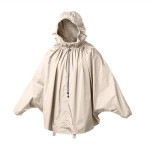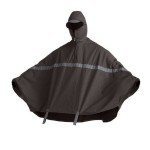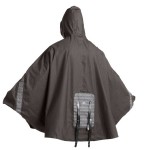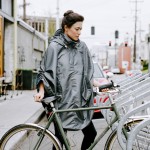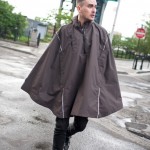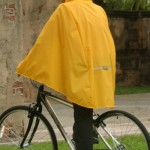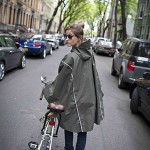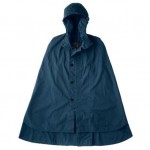There’s a relatively new kid on the rainy season block, the cycling rain cape. And no, these aren’t the dorky rain ponchos you buy in a clear pack for $12 when is starts raining at the baseball game, these are rain barriers specifically designed for riding any kind of bike.
And they work.
Sure, rain capes may look a little funny at first, but these light weight pieces are surprisingly effective and comfortable.
Why Use a Rain Cape
The key difference between cycling rain cape and a traditional rain poncho is that the body of a rain cape extends over your handlebars to create a solid tent to keep you dry.
The vast majority of rain cape users agree that rain pants are a drag. They’re awkward to put on (you probably need to take off your bike shoes) and even more awkward to remove. They are bulky and unattractive. Depending on what’s worn under them, rain pants can be rather uncomfortable.
With rain capes, it doesn’t matter what you’re wearing underneath, or what your body type is. Fit becomes less of an issue.
With one piece of clothing, you can get coverage for your head, top and bottom.
Rain capes allow for better air flow, so on days when it’s wet but not cold, they’re a great way to go.
Rain capes provide a tent of coverage from above to protect your legs, and fenders do the job from below.
Rain capes are easy to take on and off and they dry off fairly quickly.
Cape Options
How dapper you look depends on how much you want to spend, in most cases. There are a few independent fabricators making cute rain capes for under $100 that are marketed as being designed for cycling and hiking, but we can’t verify the quality of these items. Most capes range from $175-250.
Standard yellow-rain-jacket-type capes exist and are a smart choice for safety reasons, what with their bright colors and all, and they’re often the least expensive, like these from J&G Cyclewear. But better-looking options are certainly out there.
Brooks, well known for their style, offers a rain cape with leather detailing. Unless you opt for the upgraded Oxford Rollup (vs the Cambridge stowable) we don’t think it’s worth the cost because aside from the leather detailing, the cape is nothing special.
The Center for Appropriate Transport in Eugene, a hub of clever cycling, fabricates their own waxed canvas cape. It’s a nice alternative to synthetic fabrics, but it’s also much heavier. They offer optional hoods, bump outs for messenger bags, and fleece lined collars.
Cleverhood has really set the bar high, with nicely tailored capes in interesting fabrics. Billed as a “US-made rain cape for livable cities,” these capes are known for their excellent quality.
Take Into Consideration
A cape without a rear cinch will fly up in the wind. You may or may not care about this. If you do, opt for a cape that has features to prevent this.
Depending on the cape design, often it will obscure your lights, particularly on the handlebars. You’ll need to make adjustments for this, such as mounting your light to your helmet instead.
The cost isn’t all aesthetics. Many expensive caps offer handy features you’ll wish you had and reflectivity built into the classy-looking fabric. Do your research before you decide what you want to spend.
Photo Gallery
Do You Cape?
Are you a cape wearer? What do you love about it? Share your comments below.


